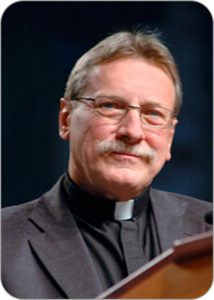
FROM THE PASTOR
See It With New Eyes
Rene Voillaume: “Jesus was born on a journey and in the midst of a great number of unkown people so he really belongs to everyone.”
Langston Hughes:
“We have no room the innkeeper called
So the glory fell where the cows were stalled
How can it be such a light shines here
In this humble stable once cold and drear
Oh the child has com to bring good cheer on a Christmas night.”
Martin Luther: “Ah Lord who madest all from clay, how couldst thou be so small and poor; To lie there in the dusty straw where ox and ass feed every day.”
Nativity scenes are all around us. Over the years in my parish ministry we had children’s processions at the beginning of each Advent liturgy. On the first Advent Sunday they would bring in the stable, the straw, and light the first candle. In successive liturgies would come the animals, the shepherds, the wise men, the mom and dad. And then the baby.
Pictures of stars, the holy family, the critters, angels, and humans adorn our homes, Christmas cards, some public squares, church lawns.
In my home congregation we would have a living nativity with real donkeys and sheep and characters from central casting. I learned that sheep don’t smell so good (You need “ewe de cologne”) after standing next to one for too long. It was a right of passage to be included in the living nativity. When I was finally of age, they made me an angel. It was humiliating. I dearly wanted one of the macho bathrobe parts. But to this day I remember being included in the nativity scene. It’s about life and God entering creation and creation entering God through that baby. It is a story to explain the world.
Maybe the wisest Christmas picture of the nativity scene was shared by a young artist about three years old on a Christmas card she made for me and proudly gave to me. There were awkward stick figures and with a little imagination one could tell and identify the figures in the nativity scene-with one exception. There were little dark dots all over the card.
“What are these?” I asked, pointing at them around what I supposed was the manger.
“That is the animal poop.” She said.
That little girl is a theologian, for she saw beyond the halos and blissful faces and sweet sentiment to the stark reality of the scene. This is a real birth here, with blood and pain and screaming, real parents worried sick in their temporary shelter from the streets, real animals chewing cuds and making animal noises and leaving droppings of poop on the straw strewn floor. These were real shepherds who heard angelic voices amid the stink of real sheep.
Look again at the pieces of the nativity scene.
- Animals. Here we see God the creator, reconciling the cosmos. Remember singing “I, said the donkey…” God is in creation, all of it.
- Stable and manger. God is in our homes. God is in shelter for the homeless. Jesus sat at something like a kitchen table as he grew up. His presence, Emanuel, makes each kitchen table, each home, an altar.
- Angels. Unlike me, angels represent praise of God. Good news is announced. Messengers go forth from the nativity scene, maybe a lot like you and me. We really are angels and the church is an angel in the world. We have good news and abundant praise.
- Shepherds. Emanuel is for Monday. In the midst of our work and routines the reign of God is breaking out.
- Wise Men. This baby, this visitation of God in human form, comes to a world full of seekers. More than ever our world needs a story and people are seeking a story that explains their lives and encompasses their deepest longing. To the seeker comes Emanuel, God with us. That story also unlocks our giftedness. We bear gifts in the world when we have bent the knee at the right place, “as with gladness, men of old…”
- Mary and Joseph. Holy Family. God’s family. Your family. Connected to all God’s children in God’s new creation.
When you see a nativity scene, see it with new eyes. See yourself in the scene. In the scene see what the poet T.S. Eliot calls the incarnation of God, “the still turning point in human history, the intersection of time and timelessness.” Fellow St. Lukan angels,
Merry Christmas!
Pastor Stephen Paul Bouman

